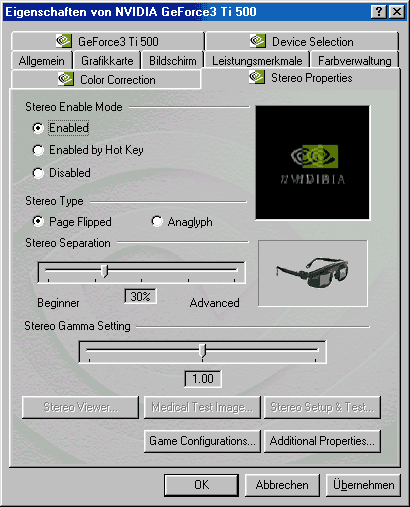Win, Lose or Ti: 21 GeForce Titanium Boards
3D Shutter Glasses
The Deluxe versions of ASUS' cards, as well as the Ti500 models by PNY and MSI, come bundled with so-called 3D shutter glasses. These glasses allow a real 3D-viewing experience, even with a conventional CRT monitor. What sounds spectacular at first is really based on a rather simple technique. The right and left side of the glasses are alternately darkened for a fraction of a second, during which time the video card driver alters the displayed image to modify the perspective of the 3D scene for the right or left eye, respectively. This way, each eye sees the same scene, but from a slightly shifted perspective. The human brain then uses the two staggered images to create a three-dimensional scene. This works quite well for the majority of users. The shutter glasses will not work for anyone with a sight defect, however. Since the brain then uses completely different methods which are based on prior experience to allow three-dimensional perception, shutter glasses would have no effect on the perceived scene.

The first thing you need to make 3D stereo vision an enjoyable experience is a very good monitor. Since the eyes alternately see the scene as it is drawn to the screen, the monitor's perceived refresh-rate is effectively halved. As a result, to play at 1024x768 with a perceived refresh rate of 70Hz, your monitor actually has to run at 140Hz, or 70Hz for each eye. Anything lower is too strenuous for the eyes, since the drop to 120Hz already means perceived 60 Hz and therefore, a flickering image.
Shutter glasses shouldn't be used for more than 30 minutes at a time in any case, as the strain on the eyes is quite great and can cause headaches and even nausea. Also, most monitors show a residual glow when the scene changes and simply can't quite keep up, leading to "ghosting artifacts" - remaining pixels meant to be displayed only for the other eye.
You can find a more detailed explanation of 3D stereo technology and the techniques behind stereo vision on NVIDIA's homepage .
Stay On the Cutting Edge: Get the Tom's Hardware Newsletter
Get Tom's Hardware's best news and in-depth reviews, straight to your inbox.
Current page: 3D Shutter Glasses
Prev Page Video Capture: Short Clips, If You Please Next Page ASUS (Deluxe Models)